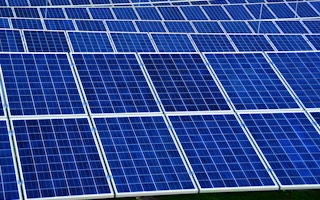The government of Bangladesh has approved construction of a large-scale solar park as part of a push to increase the share of power from renewable sources in this electricity-starved country.
The new solar park, which is due to begin generating within the next 18 months, will supply up to 200 megawatts (MW) of electricity to the national grid.
Sun Edison Energy Holding (Singapore) Pte Ltd will build the park in Teknaf sub-district, the southernmost point in mainland Bangladesh.
The solar power will be cheaper than electricity from conventional power stations. The tariff rate has been fixed at Tk 13.26 per kilowatt/hour ($0.17), two-thirds the price of electricity generated by oil-fuelled plants.
Teknaf is one of several large projects in the pipeline as the government aims to reach a target of 2,000 MW, or 10 percent of overall capacity, generated from renewable sources by 2020.
Current daily grid generation is 7,000 MW, against a peak demand of 8,500 MW, although the actual need is certainly higher since only 62 percent of the population have access to electricity through the grid.
The government plans to increase installed capacity to 20,000 MW by the end of the decade. Ahmad Kaikaus, an official at the ministry of power, energy and mineral resources, said in an interview that the government hopes that 500-600 MW of this will be generated by public-sector solar power plants.
“We have asked public-sector power companies to set up equipment for generating electricity from solar,” Kaikaus said. “They are carrying out feasibility studies.”
Kaikaus said that in addition, scores of local and foreign private-sector companies are submitting preliminary proposals to invest in solar power generation, with projects ranging in size from 5-100 MW, and the government is so far considering 14 of these.
Taposh Kumar Roy, chairman of the Sustainable and Renewable Energy Development Authority (SREDA), identified a shortage of uncultivated land in this densely populated country as a significant constraint to planning large-scale solar plants.
“Large-sized solar power plants need a huge area of land to install solar panels. In Bangladesh such barren field is hardly available. Our policy is to set up such plants only in non-agriculture lands to keep food production unhampered,” he said.
Among the places solar panels could be placed is on rooftops of residential, commercial and industrial buildings, he said.
At present, renewables account for 405 MW, or around 5.7 percent, of Bangladesh’s total daily electricity generation.
This includes 150 MW from solar home systems, and 11 MW from rooftop systems. A further 230 MW are generated by hydropower.
The government also is collecting data on wind power potential from 13 locations, he said.
Cost of the change
According to Roy, some $2.76 billion will be required to implement both large- and small-scale solar projects in the country, of which $2.23 billion is expected to come from development partners, with the rest from government and the private sector.
Ruhul Quddus, a World Bank consultant on solar home systems in Bangladesh, said renewable energy has become cost-effective as technology constantly improves.
Quddus said an investment of around $1 billion by the state-owned Infrastructure Development Company Ltd (IDCOL) has enabled the installation of some 3.7 million solar home systems since 2009, as well as solar-powered irrigation pumps and mini-grids.
The home systems have eliminated the need for 180,000 tonnes of kerosene fuel, saving an estimated $225 million annually, he said.
According to IDCOL, more than 65,000 solar home systems are now being installed each month. The company aims to finance 6 million systems by 2017, increasing the estimated generation capacity from the systems to 220 MW.
Quddus said there also are about 1.4 million diesel-fuelled irrigation pumps in Bangladesh which could instead run on solar energy.
SREDA’s Roy said most of the ongoing renewable energy projects in Bangladesh are financed by donors, with the funds managed and distributed by IDCOL.
“Since solar projects need big investment, we can’t take those from our own resources,” he said.
The government is exploring the possibility of getting money for projects from the Green Climate Fund, Roy said.
Dipal C. Barua, president of Bangladesh Solar and Renewable Energy Association, is optimistic that the government’s 10 percent target can be met through public-private partnerships.
Barua said large-scale renewable projects had not been implemented successfully in the past because of insufficient attention from the government, including a lack of feasibility studies and the absence of a tariff policy.
The government is now preparing a tariff policy to procure electricity from big renewable power grids, and this will encourage the private sector to invest, Barua added.










